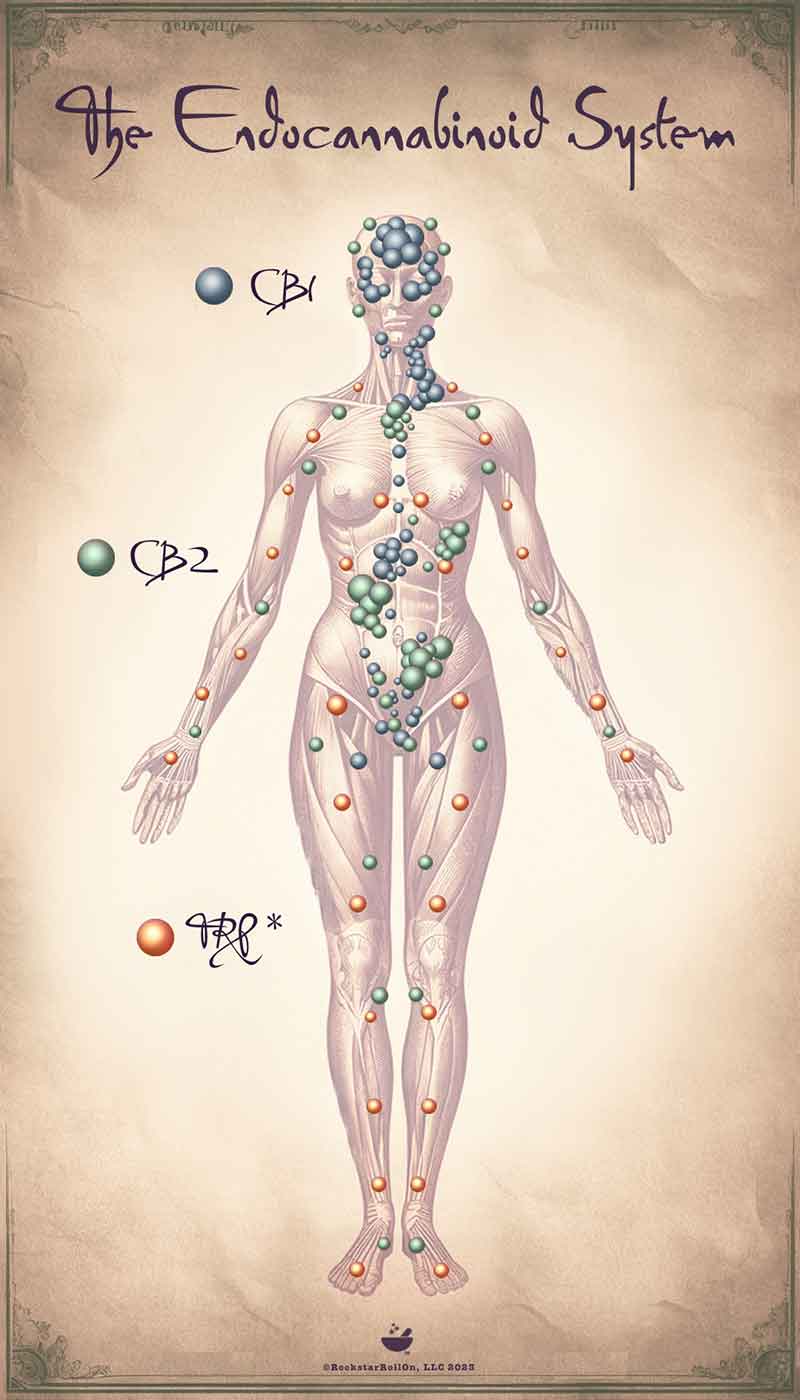Dec 14th 2023
The Endocannabinoid System: Here the Whole Time
Scientists first discovered cannabinoid receptors in the human body in the 1980s. The understanding of an entire cannabinoid system in our bodies grew from there. Research seems to have expanded in the mid 2000s - when I first started working with my doctor on my lymphatic system.
I hadn’t even heard of the endocannabinoid system back then. My doctor and I didn’t certainly didn’t discuss ‘cannabinoids’ of any kind working with botanical extracts.
Since then, the mainstreaming of medical marijuana has helped bring endocannabinoid system science more to the therapeutic forefront. This is a great development for plant based medicines and therapies derived from plants other than cannabis, too.
Homeostasis: Keeping It All Together
If we had perfectly functioning bodies and immune systems, we wouldn’t need much in the way of outside support to stay healthy beyond the basics of food, sleep and shelter. Vitamin supplements, maintenance meds and the like would be more an exception than the rule.
Science calls the body's constant activity fighting infection and balancing its activities homeostasis. Homeostasis may be most easily understood as a sort of forever balancing act. Our bodies constantly strive for optimal function, while everything in and around it constantly changes: our stress levels, our nutrition, our exposure to infection, disease, pollutants and more.
Research now indicates that the endocannabinoid system is - and always has been - the principal signaling service that communicates between, and balances homeostatic activity across, our bodily systems.
Cannabinoid Signals and CB Receptors
Endocannabinoids are chemical ‘signals’ our body sends itself. Phytocannabinoids are signals we can send ourselves with plant based medicines. These compounds act as neurotransmitters - naturally produced by some parts of our body to trigger activity in other parts. The two most well understood cannabinoids our bodies produce ('endo') to do this work are Anandamide (AEA) and 2-Arachidonoylglycerol (2-AG).
Different cannabinoids bind themselves to different receptors based on their respective chemical composition. These binding events are when receptors ‘get the message’. The primary cannabinoid receptors cluster in different systems and organs throughout our bodies, similar to lymph nodes.

When signaled, cannabinoid receptors trigger the desired activity in the surrounding system(s) with which they are associated. These resulting homeostatic events are what keep our bodies in balance.
CB1 receptors are primarily concentrated in our brain and central nervous system. Their activity appears to influence memory and motor control, and help regulate emotion and anxiety.
CB1 receptors naturally bind to cannabinoids structured like the THC molecule. They appear to be responsible for enhanced dopamine release and the general euphoric psychological effects associated with cannabis use.
CB2 receptors share chemical makeup of CB1 receptors, but have different signaling mechanisms that work independently of CB1 systems. CB2 receptors are found throughout the body in close alignment with immune system organs and tissues, including our skin.
CB2 receptor activation helps modulate inflammation, immune response and pain perception without any psychoactive effects. They naturally bind to cannabinoids structured like CBN, which is produced when THC molecules break down through oxidation. CB2 receptors also show affinity for phytocannabinoids like beta-caryophyllene, common to certain therapeutic botanical extracts.
While the most studied, most understood, and expressed in cells throughout the body, neither CB1 or CB2 receptors naturally bind with cannabinoids structured like CBD.
Rather, “... a growing body of evidence has revealed that multiple members of the transient receptor potential (TRP) ion channel family can act” as receptors to secondary cannabinoids. According to recent studies, TRP channels show binding & activation affinity with cannabinoids structured like the CBD molecule.
That study quoted above also points out that “every cell in the body expresses at least one” of these TRP channels. This suggests that every cell in our body may be open to signaling and activation by phytocannabinoids.
When Enough is Enough
The last and least well known parts of the endocannabinoid system are actually what I find the most magical. Enzymes combine to produce endocannabinoids ‘on demand’, when they receive the signal to take homeostatic action. They also cleanup after themselves when done.
Then once released, endocannabinoids cancel the original signal - basically communicating ‘mission accomplished’ to the system. The same family of enzymes then proceeds to clean up behind itself, breaking cannabinoids back down when their job is done and keeping channels clear for the next signal. Endocannabinoids are the only neurotransmitters known to act as “retrograde synaptic messengers” in this way.
The self-regulating, self-modulating aspects of the endocannabinoid system work in multiple ways. Rather than binding to receptors to enhance natural function, some cannabinoids work to inhibit natural cell function - to our benefit. I find this easier to understand when we consider the kind of signals we send our bodies with different phytocannabinoids.
As an example, we already know that CBD does not directly attach to CB receptors. In addition, CBD has been discovered to actively hinder the "retrograde messaging" activity of CB receptors. This antagonistic effect allows more endocannabinoids like the “bliss hormone” anandamide to be produced in a homeostatic event than would be otherwise. This ultimately leads to the alleviation of pain and the relaxation benefits that we associate with CBD itself.
Therapeutic Discoveries Ahead
Though research into the endocannabinoid system is now expanding, the complex interplay between activation and inhibition, agonist and antagonist cannabinoid signaling is still in early days. Many studies now operate with an established understanding that
"the endogenous cannabinoid system has significant roles in both health and disease, and that drugs which mimic, augment or block the actions of endogenously released cannabinoids” may have important therapeutic applications."
SOURCEMy own first-hand experiences developing Rockstar products reinforce the claims and promise expressed in these studies. By promoting these products and the science behind them, I hope to bring more attention and resources to this kind of research, and ultimately its translation into more effective plant-based medicines available to more people.

